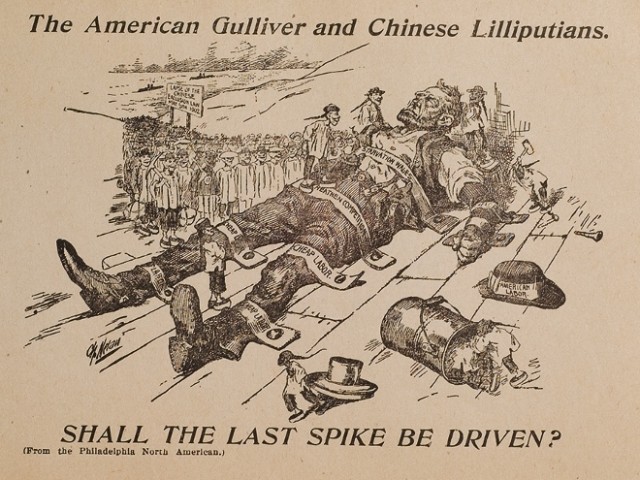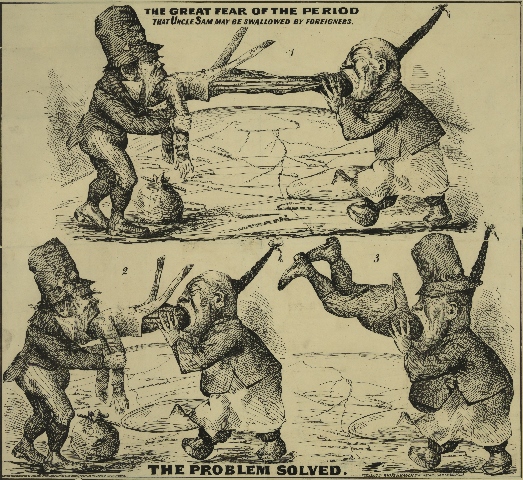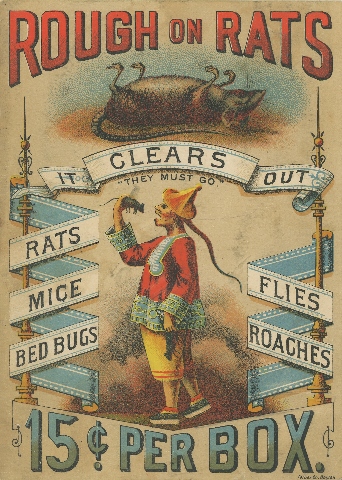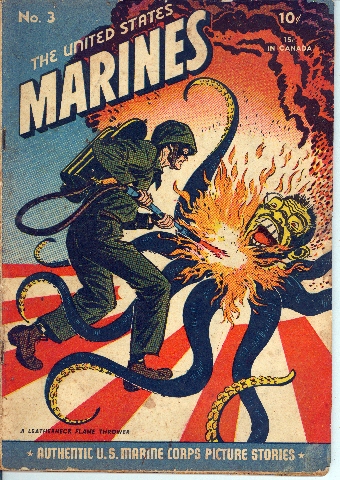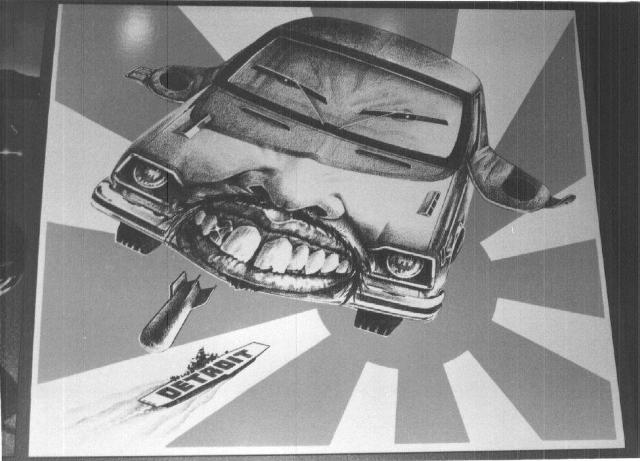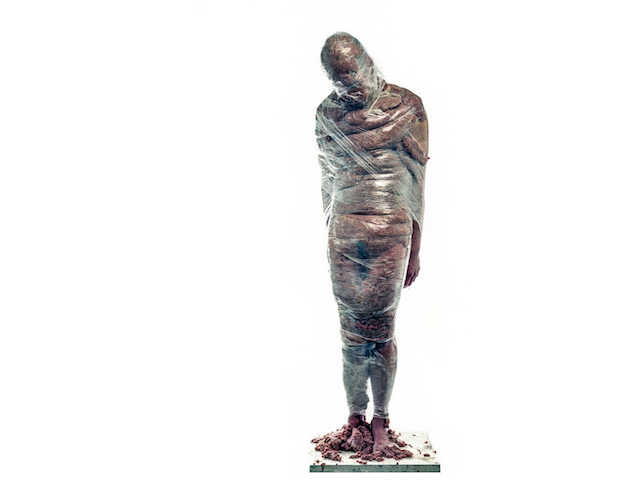How fear of the “the mob” turned into racial exclusion. Excerpts from a recently published archive of anti-Asian fear
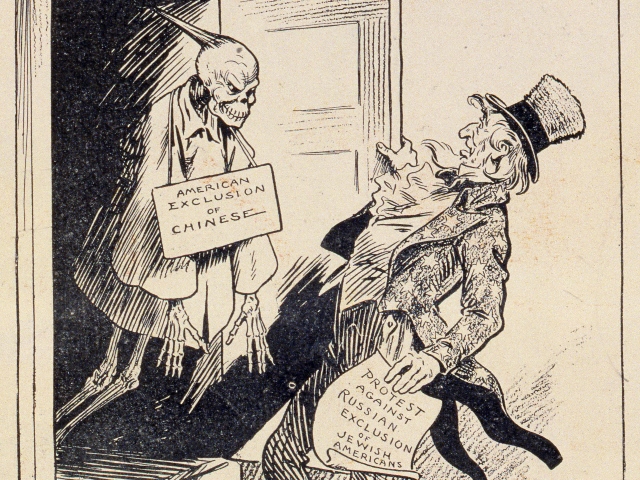
March 5, 2014
The concept of the “yellow peril” is centuries old, and although today it brings to mind racist fears of East Asia, some of its first uses refer to West and South Asia. As John Kuo Wei Tchen and Dylan Yeats lay out in their rich documentary survey of the persistence of anti-Asian paranoia in literature, art, pop culture, and everyday life, “yellow is part of a visual imaginary that varies in relation to the extension of European colonization into ‘the Orient.'” The object of blame—the “other”—is always shifting.
In the 19th century, the concept took on a new life in the US with the expansion westward. The white protestant promise that pioneers would find new beginnings in the west turned out to be an empty one, and the Chinese in America, then working the railroads along the Pacific, became the ones to blame. Class conflict turned racial. Below is a gallery of images from the book and three short excerpts from Yellow Peril! that describe how yellow perilist scapegoating of immigrants in the US arose, a Chinese view of the Statue of Liberty, and the legacies of “yellow peril” in immigration law that are with us today. To read an interview with the authors of Yellow Peril!, check out “From Coolie to Googlebot” on CultureStrike.
The Enemy Within
Throughout U.S. history, politicians and pundits have reshaped the meaning of “America” amid moral panics and national dilemmas. Depicting Chinese immigrants as potential threats to national security in the 1880s secured Congress’s exclusive Constitutional right to regulate immigration as a function of its war powers, internal and external. This became the policy precedent for subsequent immigration exclusion laws and culture wars. Rooting the institutional origins and political logic of the idea of “unassimilable” foreigners (be they racially and/or ideologically unfit for participation in American democracy) in this earlier history helps us carry analysis of the role of yellow perilism forward through the subsequent mid-century variations of the “Red Scare” and more recent calls for excluding “undesirable” and “un-American” groups. Maintaining a narrow notion of proper Americanism, in the face of these supposed threats, has profoundly shaped U.S. political culture.
Over the nineteenth century, the extension of popular democracy and the development of industries provoked a fear of “the mob.” Elite Americans looked on anxiously at what they considered to be the excesses of the French Revolution and its disregard for life and property. At home, the boisterous parades that typified the Revolutionary period morphed into more formalized political parties holding orderly conventions. Immigration complicated this already fraught situation. Samuel Morse saw unregulated immigration as a “conspiracy,” for Catholic emigrants were “but obedient instruments in the hands of their more knowing leaders, to accomplish the Indispensable Enemies designs of their foreign masters.” Critics also regularly compared Mormons to Oriental fanatics, or a “tribe of locusts” whose “swarm of emigrants from their pestilent hive” threatened the free American experiment. Carroll Wright considered French Canadian millworkers in New England “the Chinese of the Eastern States … a horde of industrial invaders, not a stream of stable settlers.”

This racial civilizational logic led to Chinese Exclusion in 1882 and set the stage for a broader culture of political scapegoating. Eugenicists, for example, claimed inferior races infused with “primitive” African and “semi-civilized” Mongol blood degraded workplaces and neighborhoods, and threatened the stability of the entire social system. Reformers sought to assimilate new European immigrants into “American” standards of living, blaming poor living conditions and crime on Old World cultures, not the poverty of the industrializing machine. Japanese, Korean, Indian, Italian, Russian, and Jewish hordes joined the Chinese as the targets of exclusion in the early twentieth century. When Attorney General Michael Palmer described the “lopsided faces, sloping brows, and misshapen features” of supposedly dangerous radicals in 1919, he linked the American eugenics movement, which dismissed social problems and political opposition as rooted in cultural and biological depravity, to American anti-Communism.
This institutional exclusion of dangerous and intermingling Oriental peoples and ideas provided a framework for understanding the challenges ahead. Under the banner of anti-Communism, the federal government waged war against homosexuality, labor-organizing, civil rights, and antiwar activists. Today, U.S. political parties compete over who is tougher on terrorism and China. A tight-knit network of think tanks mobilize disaffected Americans around the newly fabricated “heathen” threat of Sharia Law and Muslim American “radicalization.” FBI informants pressure angry youth on the margins of society to plot “terrorist” acts so they can arrest them. Government operatives infiltrate mosques and antiwar groups to observe and disrupt lawful assemblies. Though ultimately fanciful, these fearmongering techniques have real effects. They silence opposition from the most vulnerable communities, and they focus the anxieties of millions of Americans away from the problems haunting liberalism and onto easy-tohate scapegoats.
Arab “control” of oil prices, Japanese “unfair” competition, and the Chinese “manipulation” of currency help politicians and pundits protect Americans from understanding the glaring domestic policy failures underpinning their economic woes. This civilizational-clash framework, built over generations of misinformation, justifies the request for Americans to give up the promise once again. It is no longer the “Asiatic mode of production” or Asian Communism but Asian Capitalism that threatens “the American way of life.” U.S. deficit spending, once necessary to fight Communism, now imperils the nation. The only constant amid these shifting and contradictory threats to the American Dream, is that Oriental enemies, not U.S. government actions nor corporate practices, are always to blame.
Yellow perilist scapegoating obscures the effective analysis of U.S. political debates, but also ostracizes, silences, and sometimes sacrifices individuals and communities on the altar of American fantasy. State repression and vigilante violence has suppressed myriad efforts by communities of color to organize for their survival and success. At the same time, the politics of resentment and suspicion provoke some, desperate to hold on to what they imagine to be theirs, to harass, discriminate, and attack their “un-American” neighbors.
*
Saum Song Bo, “A Chinese View of the Statue of Liberty” (1885)
This letter, written by a Chinese American shortly after the passage of the 1882 Chinese Exclusion Act, condemns the hypocrisy of an exclusionary theory of liberty. Ironically, Emma Lazarus had famously celebrated the promise of the “huddled masses yearning to breathe free” in America in Joseph Pulitzer’s (also an immigrant) New York World that same year as part of the campaign to finance the construction of the Statue of Liberty pedestal. Saum Song Bo (n.d.) connects his own exclusion from American citizenship with French imperialism in Southeast Asia.
Sir:
A paper was presented to me yesterday for inspection, and I found it to be specially drawn up for subscription among my countrymen toward the Pedestal Fund of the Bartholdi Statue of Liberty. Seeing that the heading is an appeal to American citizens, to their love of country and liberty, I feel that my countrymen and myself are honored in being thus appealed to as citizens in the cause of liberty. But the word liberty makes me think of the fact that this country is the land of liberty for men of all nations except the Chinese. I consider it an insult to us Chinese to call on us to contribute toward building in this land a pedestal for a statue of Liberty. That statue represents Liberty holding a torch which lights the passage of those of all nations who come into this country. But are the Chinese allowed to come? As for the Chinese who are here, are they allowed to enjoy liberty as men of all other nationalities enjoy it? Are they allowed to go about everywhere free from the insults, abuse, assaults, wrongs, and injuries from which men of other nationalities are free?
If there be a Chinaman who came to this country when a lad, who has passed through an American institution of learning of the highest grade, who has so fallen in love with American manners and ideas that he desires to make his home in this land, and who, seeing that his countrymen demand one of their own number to be their legal adviser, representative, advocate, and protector, desires to study law, can he be a lawyer? By the law of this nation, he, being a Chinaman, cannot become a citizen, and consequently cannot be a lawyer.
And this statue of Liberty is a gift to a people from another people who do not love or value liberty for the Chinese. Are not the Annamese and Tonquinese Chinese, to whom liberty is as dear as to the French? What right have the French to deprive them of their liberty?
Whether this statute against the Chinese or the statue to Liberty will be the more lasting monument to tell future ages of the liberty and greatness of this country, will be known only to future generations.
Liberty, we Chinese do love and adore thee; but let not those who deny thee to us, make of thee a graven image and invite us to bow down to it.
“The Chinese Exclusion Case” (1889)
Americans have always defended themselves against discriminatory legislation and fought for equal protection under the Constitution. The Chinese Exclusion Act never really worked, for immigrant laborers found ways to circumvent the law that rendered them illegal. As a result, Congress sought to tighten the law such that no Chinese could reenter the U.S. even if they had entered prior to the enactment of Exclusion. Chae Chan Ping (n.d.) traveled to China to attend to his father’s death before the Exclusion Act was tightened and left his family in California. Immigration authorities would not let him return under the newly expanded act. Ping challenged that Congress could not deport a Chinese citizen entitled to reside in the U.S. under the Burlingame Treaty of 1868. The resulting decision, excerpted below, justified legislative oversight over immigration irrespective of treaty obligations as an extension of Congressional war powers. This decision serves as the basis of all immigration law in the U.S. to this day.
That the government of the United States, through the action of the legislative department, can exclude aliens from its territory is a proposition which we do not think open to controversy. Jurisdiction over its own territory to that extent is an incident of every independent nation. It is a part of its independence …
To preserve its independence, and give security against foreign aggression and encroachment, is the highest duty of every nation, and to attain these ends nearly all other considerations are to be subordinated. It matters not in what form such aggression and encroachment come, whether from the foreign nation acting in its national character, or from vast hordes of its people crowding in upon us. The government, possessing the powers which are to be exercised for protection and security, is clothed with authority to determine the occasion on which the powers shall be called forth, and its determinations, so far as the subjects affected are concerned, are necessarily conclusive upon all its departments and officers. If, therefore, the government of the United States, through its legislative department, considers the presence of foreigners of a different race in this country, who will not assimilate with us, to be dangerous to its peace and security, their exclusion is not to be stayed because at the time there are no actual hostilities with the nation of which the foreigners are subjects. The existence of war would render the necessity of the proceeding only more obvious and pressing. The same necessity, in a less pressing degree, may arise when war does not exist, and the same authority which adjudges the necessity in one case must also determine it in the other …
The exclusion of paupers, criminals, and persons afflicted with incurable diseases, for which statutes have been passed, is only an application of the same power to particular classes of persons, whose presence is deemed injurious or a source of danger to the country. As applied to them, there has never been any question as to the power to exclude them. The power is constantly exercised; its existence is involved in the right of selfpreservation …
Excerpted from YELLOW PERIL! by John Kuo Wei Tchen and Dylan Yeats by arrangement with Verso Books, Copyright © 2014
—
Join the authors along with guest performers and speakers this Friday, March 7, at NYU’s A/P/A Institute to celebrate the publication of Yellow Peril!

